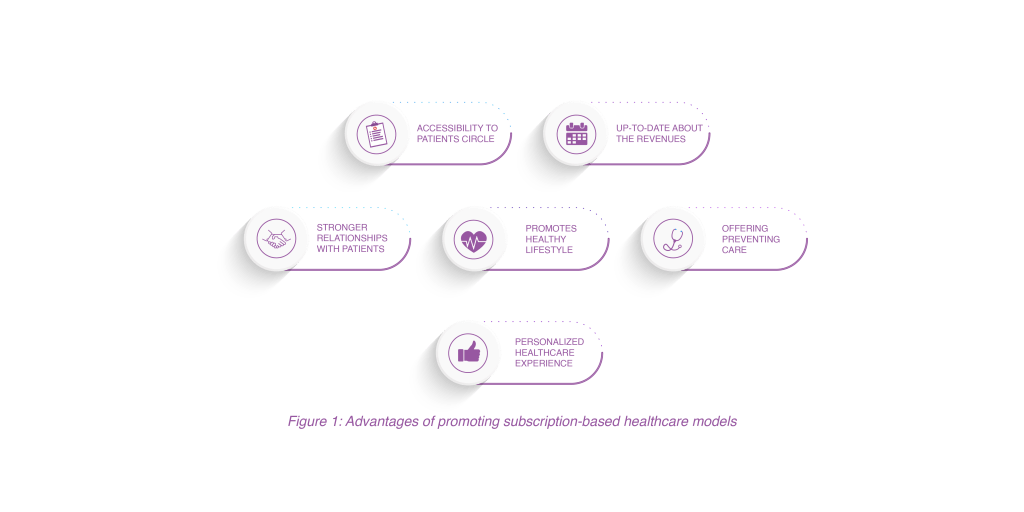EXPLORING SUBSCRIPTION-BASED MODELS
A PARADIGM SHIFT IN HEALTHCARE: EXPLORING SUBSCRIPTION-BASED MODELS
Healthcare providers shoulder numerous responsibilities toward their patients and are
constantly seeking ways to improve their services. While subscription-based models have
found success in various industries like entertainment with the likes of Netflix and Amazon,
their application in healthcare is relatively new. Consequently, many healthcare providers are
still acquainting themselves with the intricacies of this approach. Upon subscribing to a
healthcare model based on subscriptions, patients willingly commit to a specific timeframe,
during which they gain access to dedicated time, facilities, and a range of offered services
By introducing subscription-based models in healthcare, providers can extend an array of
services including primary care, specialized consultations, and telemedicine. These models
offer convenience and ease of use for both healthcare providers and patients, with upfront
payment methods that streamline the process
UNVEILING THE SIGNIFICANCE OF SUBCRIBTION-BASED HEALTHCARE MODELS
EXPANDING ACCESS TO A WIDER PATIENT BASE
In today’s healthcare landscape, one of the modern approaches to enhance practice and reach
a broader audience is through the implementation of subscription-based healthcare models
(SBHM). By offering SBHMs, patients can gain access to personalized healthcare services
based on their individual health preferences, thereby ensuring accessibility for a diverse patient
circle. This expansion facilitates a wider customer base, promoting financial stability and growth
for healthcare providers.
FOSTERING STRONG PATIENT RELATIONSHIPS
SBHMs play a pivotal role in elevating the patient experience by providing increased healthcare
resources and convenient access. This fosters long-term relationships between healthcare
providers and patients, as telehealth appointments allow for flexibility in scheduling
consultations. Furthermore, SBHMs empower patients by enabling them to seek consultations
from different doctors or specific specialists, facilitating second opinions, and enhancing their
engagement in managing their health.
EMPOWERING INDIVIDUALS THROUGH HEALTHY LIFESTYLES
With fewer patients in the queue, healthcare providers utilizing SBHMs can allocate dedicated
time to focus on each patient, delivering quality healthcare services and yielding positive health
outcomes. This personalized attention fosters patient engagement in utilizing available health
resources, promoting a healthy lifestyle. Additionally, the financial commitment made by
patients through their subscription model serves as a motivating factor, encouraging greater
utilization of healthcare services offered through the model.
EMPHASIZING PREVENTIVE MEDICINE
SBHMs embrace shared responsibilities with healthcare providers by emphasizing on
preventive care and early interventions facilitated through telehealth apps. This proactive
approach helps avoid emergencies and significantly reduces hospitalizations and emergency
room visits. Studies have shown that primary care models, such as those offered by IORA
Health, resulted in a 40% reduction in hospitalizations and 20% fewer emergency room
vists, highlighting the effectiveness of SBHMs in minimizing unnecessary hopital admissions.
UNLOCKING FINANCIAL INSIGHTS AND BUDGETING
SBHMs provide healthcare providers with the opportunity to creatively structure monthly or
yearly healthcare packages that cater to patients’ financial affordability. This enables providers
to attract a wider patient base while maintaining affordable SBHMs. By gaining insights into
incoming revenue through SBHMs, providers can stay up-to-date with financial estimates,
enabling more informed decision-making and effective budgeting.
CREATING PERSONALIZED EXPERIENCES
SBHMs facilitate quick and personalized online healthcare services, crafting a one-on-one
experience for patients. Online telehealth services eliminate network restrictions, ensuring
seamless delivery of healthcare. The sharing of information within each subscription-based
telehealth model revolves around individual healthcare preferences and needs, further
enhancing the patient experience.
COMMON CHALLENGES FACED WHEN INTRODUCING SBHM
Affordability : Some patients may find the SBHM not affordable as they are used to getting
healthcare services for free and will be hesitant in spending a specific amount in
subscribing to these healthcare models.
Solution: This includes highlighting the comprehensive and personalized care patients will
receive in exchange for their subscription fee. By clearly communicating the benefits of
proactive and preventive care, providers can help patients understand the long-term cost
savings and improved health outcomes associated with SBHMs. Flexible pricing options
and financial assistance programs can also be explored to accommodate patients with
varying financial capabilities.
Upskill Existing Healthcare System: Implementing subscription-based models may require
additional knowledge and skills related to telehealth technology, patient engagement
strategies, and personalized care delivery.
Solution: To address this challenge, healthcare providers can implement
the following strategies:
Comprehensive Training Programs
Continuous Education
Cross-Functional Collaboration
Regular Performance Feedback
By prioritizing continuous education, training, and adapting to new changes, healthcare providers
can overcome the challenges associated with implementing SBHMs and ensure a smooth
transition for both patients and healthcare workers.
Billing and Charting: The implementation of SBHMs may require adjustments to billing and
charting processes. Healthcare providers must ensure that their systems and workflows are
equipped to handle the unique billing requirements associated with SBHMs. This may involve
integrating new software or updating existing systems to accurately track and process
subscription-based payments, while also maintaining comprehensive and compliant
medical charts.
Public Health Plans: SBHMs may have implications for public health plans, as they introduce
a new payment model that differs from traditional fee-for-service arrangements. Healthcare
providers should proactively engage with public health plan administrators and policymakers to
understand any potential impacts or considerations. Collaboration and open dialogue can help
navigate any regulatory or reimbursement challenges that may arise.
Compliance: Compliance with healthcare regulations and standards remains paramount when
implementing SBHMs. Providers must ensure that their subscription-based models align with
relevant laws, including patient privacy and data protection regulations. It is quite beneficial to
maintain accurate and up-to-date documentation, obtain informed consent, and protect patient
information through secure digital platforms.
By robustly addressing these aspects and focusing on affordability, billing, charting, public
health plans, and compliance, healthcare providers can navigate the challenges associated
with implementing SBHMs. This proactive approach ensures a smooth transition, fosters
patient trust, and enhances overall healthcare delivery while complying with regulatory
requirements and maintaining public health standards.

The implementation of subscription-based models in the healthcare industry holds immense
potential and numerous hidden advantages. By embracing this innovative approach, healthcare
providers can not only enhance patient satisfaction but also target a wider consumer market,
leading to an increase in revenue. Through the provision of hands-on healthcare features
tailored to individual health conditions, subscription-based models offer personalized and
comprehensive care to patients. This proactive approach helps healthcare providers improve
the quality of services they offer and contribute to better health outcomes.
Additionally, the predictable revenue generated by subscription-based models allows for
effective financial planning and investment in technology and staff, further improving the overall
healthcare experience. Embracing subscription-based models in the healthcare sector is a
forward-thinking strategy that benefits both providers and patients, paving the way for a more
patient-centered and sustainable healthcare system.
